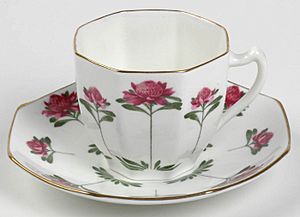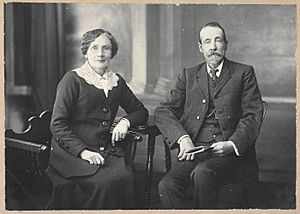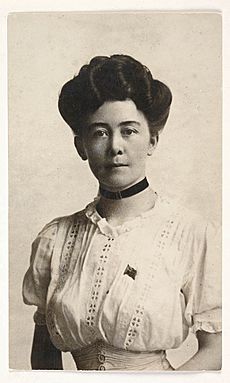Miles Franklin facts for kids
Quick facts for kids
Miles Franklin
|
|
|---|---|

Franklin, c.1940s
|
|
| Born |
Stella Maria Sarah Miles Franklin
14 October 1879 Talbingo, New South Wales, Australia
|
| Died | 19 September 1954 (aged 74) Drummoyne, New South Wales, Australia
|
| Other names | Brent of Bin Bin, An Old Bachelor, Vernacular, Ogniblat, Mr and Mrs Ogniblat L'Artsau |
| Known for | Novelist, writer, feminist |
Stella Maria Sarah Miles Franklin (born October 14, 1879 – died September 19, 1954), known as Miles Franklin, was a famous Australian writer. She was also a strong supporter of women's rights, known as a feminist.
Her most famous book is My Brilliant Career, published in 1901. Even though she wrote many books, her next big success, All That Swagger, came out much later in 1936.
Miles Franklin really wanted Australian stories to be special and unique. She helped other writers and literary groups. Today, her legacy lives on through the Miles Franklin Award. This is a major yearly prize for books about "Australian Life." In 2013, the Stella Prize was also created. It celebrates the best books written by Australian women.
Contents
Miles Franklin's Early Life and Writing Career
Miles Franklin was born in Talbingo, New South Wales. She grew up in the Brindabella Valley on a property called Brindabella Station. She was the oldest child of John Maurice Franklin and Susannah Margaret Eleanor Franklin. Her family had been in Australia for a long time.
She learned at home until 1889. Then she went to Thornford Public School. Her teachers, Mary Gillespie and Tom Hebblewhite, encouraged her writing. Tom Hebblewhite was an editor for a local newspaper in Goulburn.
Her most famous book, My Brilliant Career, is about a feisty teenage girl. Her name is Sybylla Melvyn. The story shows her growing up in the countryside of New South Wales. The famous Australian writer Henry Lawson helped her publish it in 1901.
After her book came out, Franklin tried nursing. She also worked as a housemaid in Sydney and Melbourne. During this time, she wrote for newspapers. She used pen names like "An Old Bachelor" and "Vernacular." She also wrote My Career Goes Bung, but it was not published until 1946. This book shows Sybylla meeting Sydney's literary world.
Life in the United States and England
In 1906, Franklin moved to the United States. She worked as a secretary for Alice Henry in Chicago. Alice Henry was another Australian. They worked at the National Women's Trade Union League. Franklin also helped edit their magazine, Life and Labor.
Her time in the US inspired her book On Dearborn Street. This love story uses American slang. It was not published until 1981. While in America, she also wrote Some Everyday Folk and Dawn (1909). This book is about an Australian family in a small town. She sometimes had poor health. In 1912, she stayed in a special hospital for a while.
In 1915, she traveled to England. She worked as a cook and earned money from writing for newspapers. In 1917, Franklin volunteered for war work. She joined the Scottish Women's Hospitals in Serbia. She worked as a cook and orderly in a hospital tent. This hospital was near Lake Ostrovo in Macedonian Greece. She worked there from July 1917 to February 1918.
Was made staff cook against my will. ... Then Miss Brown made a row with everyone & insisted on being head. I just let 'em muddle along and take no notice as I've had a year's training in London of English ways. Will think my own thoughts and write a book if the plot comes into my head.
From 1919 to 1926, Franklin worked in London. She was a secretary for a housing group. She helped organize a women's housing meeting in 1924. Her experiences in England inspired Bring the Monkey (1933). This book made fun of English mystery novels. It showed Franklin's ideas about different countries and social classes. However, the book was not very successful.
Returning to Australia
Franklin moved back to Australia in 1932. Her father had passed away in 1931. In the 1930s, she wrote several historical novels. These books were about the Australian bush. Most were published using the pen name "Brent of Bin Bin."
Miles Franklin worried that her new books would not be as popular as My Brilliant Career. So she used different names to protect herself from bad reviews. However, All That Swagger was published under her own name in 1936. It won the S. H. Prior Memorial Prize. She also won this prize in 1939 with Kate Baker. They won for their work on 'Who Was Joseph Furphy?'.
Franklin always supported Australian literature. She joined the Fellowship of Australian Writers in 1933. She also joined the Sydney PEN Club in 1935. She encouraged young writers like Jean Devanny and Sumner Locke Elliott. She also supported new literary magazines.
Miles Franklin often hosted writers at her home. She had a special autograph book called Miles Franklin's Waratah Book. Guests would drink tea from her Waratah Cup and write in the book.

In 1937, Franklin was offered an award from the British Empire. She politely declined it.
During this time, Franklin spoke at many cultural events. She always talked about free speech. She also championed Australian literature. She was not part of any political party. However, her diaries show she was interested in socialism. She was strongly against war. Her experiences in World War I made her fear another war.
Miles Franklin never married. She died on September 19, 1954, at age 74. Her ashes were scattered in Jounama Creek, near where she was born.
Working with Other Writers
Miles Franklin worked with other writers often. She co-edited Life and Labor with Alice Henry in the US. She also wrote Pioneers on Parade with Dymphna Cusack. She wrote a biography of Joseph Furphy with Kate Baker in 1944. They had won a prize for an essay on Furphy in 1939.
Letters between Dymphna Cusack and Miles Franklin show how they worked together. They reveal the challenges and joys of writing with someone else.
Miles Franklin's Lasting Legacy

In her will, Miles Franklin left money to create a literary award. This award is now called The Miles Franklin Award. The first winner was Patrick White in 1957 for his book Voss.
A suburb in Canberra is named Franklin in her honor. The nearby Miles Franklin Primary School is also named after her. This school holds a writing competition every year. The Franklin Public School in Tumut, NSW, is also named for her.
Miles Franklin gave many items to the Mitchell Library during her life. These included her writings and notes. She also left her book collection and letters. 47 of her diaries are kept at the State Library of New South Wales. One diary was found as recently as 2018.
Interest in Franklin grew again after the Australian film My Brilliant Career came out in 1979. This movie won many international awards.
In 2014, Google Doodle celebrated her 135th birthday.
In 2022, Gail Jones wrote a novel called Salonika Burning. Miles Franklin (called 'Stella') is a main character in this book. It tells about her experiences in Macedonia during the war.
Awards and Recognition
- 1936: S. H. Prior Memorial Prize for All that Swagger
- 1939: S. H. Prior Memorial Prize for Joseph Furphy: The Legend of a Man and His Book
Selected Books
Novels by Miles Franklin
- My Brilliant Career (1901)
- Some Everyday Folk and Dawn (1909)
- Old Blastus of Bandicoot (1931)
- Bring the Monkey (1933)
- All That Swagger (1936)
- Pioneers on Parade (1939) – written with Dymphna Cusack
- My Career Goes Bung (1946)
- The Thorny Rose (1947)
- On Dearborn Street (1981)
Novels by "Brent of Bin Bin" (Miles Franklin's pen name)
- Up the Country (1928)
- Ten Creeks Run (1930)
- Back to Bool Bool (1931)
- Prelude to Waking (1950)
- Cockatoos (1954)
- Gentleman at Gyang Gyang (1956)
Non-fiction Books
- Joseph Furphy: The Legend of a Man and His Book (1944)
- Laughter, Not for a Cage (1956)
- Childhood at Brindabella (1963)
See also
 In Spanish: Miles Franklin para niños
In Spanish: Miles Franklin para niños




